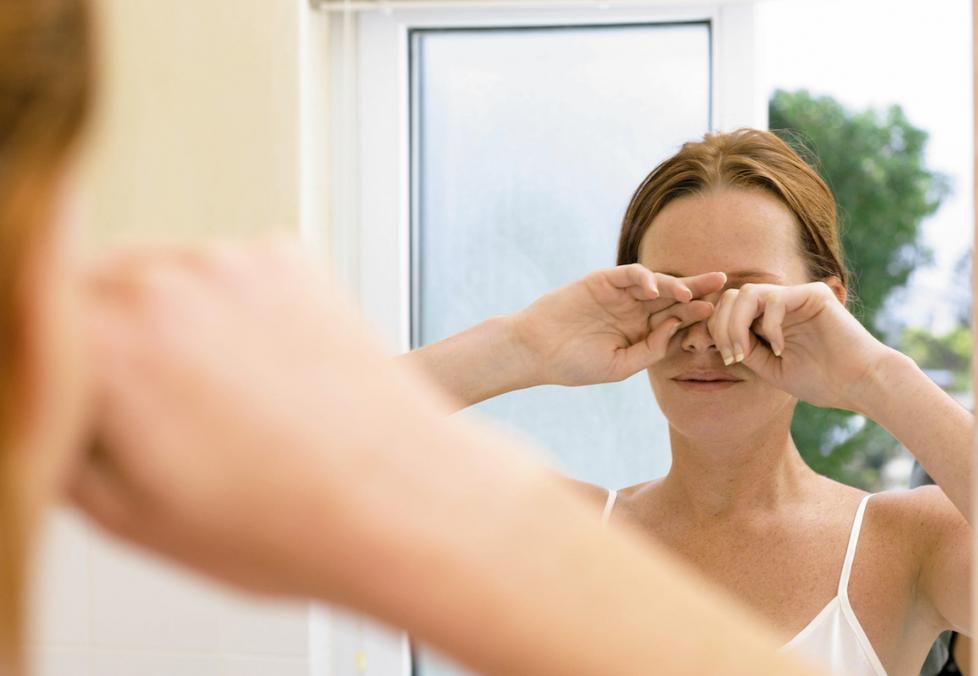
Yes, it’s allergy season. But before you and your irritated eyes play the blame game, read this.

The weather’s balmy, your garden’s bloomy, and your eyes are itchy. Seasonal allergies, right? Not so fast.
“An itchy eye has to be approached on a case-by-case basis, because it can be caused by a number of things,” says Cynthia Collins, O.D., an optometrist at America’s Best in North Myrtle Beach, South Carolina.
Allergies are, in fact, the most likely culprit. More than 25 million Americans suffer from allergic rhinitis, and itchy eyes are a primary symptom. The reason? Your eye is welcoming to intruders, with its moist, sticky surface allowing airborne particles to hitch a ride. And the hitch-to-itch cycle can be very short.
But any substance that sends the body’s immune system into overdrive can bring on allergy-like symptoms, including itching. These include dust mites, mold, animal dander, cosmetics, personal care items, and certain foods—or bacterial infections and viruses.
“You can even become allergic to your own contact lens, and that creates itching,” says Dr. Collins.
Here are eight common causes of itchy eyes that you could easily mistake for an allergy—plus, what to do about each.
Have questions about your eye health or vision? Your America’s Best optometrist is here to help. Click here to find an exam time that fits your schedule.
Allergy Impostor #1: Conjunctivitis
If one eye is irritated, itchy, red, or glued shut with a yellow-green crust, you’ve probably got pink eye (aka conjunctivitis), not an allergy.
“Seasonal allergies always occur in both eyes,” explains Andrew Murphy, M.D.,allergist and immunologist at the Asthma, Allergy & Sinus Center of West Chester, Pennsylvania.
Conjunctivitis is notoriously infectious, particularly among preschoolers, who often spread it to siblings and parents. Bacterial versions usually clear up within a day or two of treatment, but viral infections are peskier. They can take a week or two to clear.
That said, a povidone-iodine solution called Betadine can shorten the course of viral infection. “The eye is sterilized with Betadine to immediately end the contagion,” says Dr. Collins. A topical anesthetic helps make this uncomfortable treatment less so.

Allergy Impostor #2: Contact Dermatitis
This skin condition raises a red, itchy rash on the lids or the areas surrounding the eye. It’s caused by direct contact with an offending substance and responds to prescription medication or hydrocortisone-based cream.
But be careful. “If you use over-the-counter steroids, remember that anything on your eyelid can wind up in your eyes, and that can increase the long-term risk for glaucoma and cataracts,” Dr. Murphy says.
Allergy Impostor #3: Dry Eye
Insufficient moisture can make your eyes itch, as well as burn, sting, water (ironically), and even blur.
For minor cases, over-the-counter lubricating drops can help. But avoid drops marketed as being for redness reduction, as they cause the blood vessels to constrict. When they are discontinued, rebound redness occurs and eyes are redder than they were before.
Allergy Impostor #4: Eyestrain
Eyestrain and dry eye tend to travel together—often right from the computer monitor.
“Looking at the screen, you blink only about four times a minute,” explains Dr. Collins. “You should be blinking up to 15 times a minute to keep the eye lubricated.”
At the computer, follow the 20-20-20 rule: every 20 minutes, gaze 20 feet away for 20 seconds to relax and moisten eyes.
Allergy Impostor #5: Giant Papillary Conjunctivitis
Contact lenses trap allergens and irritants that can spark this scary-sounding condition. It occurs when your contaminated lenses rub against the underside of the eyelid, creating bumps that make contact wearing miserable.
“It feels like itchy sandpaper, as if a gritty foreign body is in the eye,” says Dr. Collins. If it happens to you, see your doctor and take a break from contacts. When you’ve healed, practice scrupulous contact lens hygiene.
Allergy Impostor #6: Blepharitis
This chronic inflammation clogs the oil glands near the base of the eyelids. It can affect the whole lid, the margin that meets the eye, or the lid’s underside. Left untreated, it can inflame the cornea, kill eyelashes, and provide a nest for nasty parasites.
The ailment tends to plague fair or ginger-complexioned people and those with the skin condition rosacea, as well as the elderly, who may develop red, droopy-looking eyes. The itchy, flaking skin can form a crust that glues eyes together in the morning.
To reduce symptoms, blepharitis patients are often taught to cleanse the lids with a special solution—a blend of no-tears shampoo and water or medicated eyelid cleanser, depending on the severity. Warm compresses also help. If parasitic mites move in, more aggressive cleansing is needed.
Allergy Impostor #7: Vernal Conjunctivitis
This chronic allergic reaction often targets young males. They eventually outgrow it, but cold compresses can dampen itching and redness in the meantime.
Certain medications can help, too. Recently, doctors have had success with a milder version of the immunosuppressive drug cyclosporine.
Allergy Impostor #8: Minor Injuries
It’s hard not to rub an itchy eye, but constant touching can create an abrasion—and truly aggressive rubbing can cause permanent damage.
“Over a long period, the constant rubbing can change the shape of your cornea and lead to scarring that makes the front of the eye steeper,” says Jessica Lee, M.D., an ophthalmologist with the New York Eye and Ear Infirmary of Mount Sinai in New York City.
Home Remedies to Try
Bonus: they’ll help with seasonal allergies as well.
Cool compresses: Place a wet, cool cloth over your eyes to soothe itching and minimize swelling.
Drops: Antihistamine drops cut itchiness, while lubricating drops wash away irritants. Note: antihistamines may reduce tear production, so stick with lubricating drops if you’re suffering from dry eye.
Eyelid cleaning: Nightly washing ensures allergens that accumulate during the day don’t stick around. Cover your eyes with a warm compress, then remove the compress and gently clean your lids with a cotton swab or washcloth dampened with diluted baby shampoo.
If these remedies don’t ease the sting, talk to your doctor to identify the root cause. They can recommend over-the-counter or prescription medications that may help. Among the options: antihistamines, mast cell stabilizers, anticholinergics, decongestants-vasoconstrictors, corticosteroids, multimodal anti-allergic agents, NSAIDs, and immuno-modulators.
Once you’re in the clear, prevent a recurrence by wearing sunglasses and a hat outdoors. Both provide an extra barrier for irritants (including seasonal allergens like pollen) to cross.
Indoors, keep the house sealed—especially during allergy season—and frequently wash clothing that’s been outside. Consider taking a shower before bedtime to wash away potential irritants.
Finally, a promising new remedy for itchy eyes is on the horizon. A June 2019 paper concluded that medicated contact lenses, engineered to deliver antihistamines right to the eye, produced “clinically significant” reductions in itching during phase-three clinical testing.



